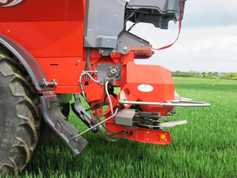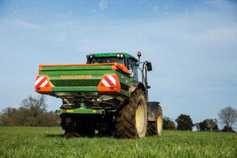Our measuring beef farms have grown a respectable 28kg DM/ha/day since last week. This ranges from 13kg DM in Co Sligo to 43kg DM in Meath, though there remains big variation within regions, with factors like soil type, fertility and fertiliser inputs obviously at play.
The weekend’s weather has taken big pressure off spring-calving herds, as most were able to get cows and calves to grass. Unfortunately the outlook for this weekend is mixed.
Those on heavy ground should consider the forecast before letting more cows and calves out in the coming days. While temperatures are set to remain high, persistent showery weather is not the ideal start for a young calf. Also, is the ground able for more big cows if things get wet?
Focus instead on keeping out those that turned out last week. If you’re worried about ground cutting up, don’t be afraid to stand cows and calves in a yard temporarily until rain ceases.
If they have to come indoors, so what? Save for the inconvenience, there is no harm in taking animals inside. However, if a deluge is forecast, ideally do so before they get wet. Where possible, calves should be let creep outdoors in all cases. Opening a shed door and tying a plank of wood just above waist height will do the trick.
Growth is well ahead of last year, but it has been a difficult spring for early grazers. Many of the country’s top grass farmers are reporting that farm covers are well up on where they should be and the danger now is that grass will get away from them if a burst arrives in the coming weeks. Don’t be afraid to skip paddocks and pull the mower out in April if a good spell comes. There is no rule against making bales this early.
Avoid letting grass accumulate between skipping and cutting paddocks too. When taking out paddocks, we should always be aiming for a three-bale/acre yield. It might seem low, but what’s wrapped up will be winter rocket fuel.
If unsure about whether or not you can afford to take these heavy paddocks out, remember that April is when the magic day typically arrives: grass growth exceeds demand even on the heaviest-stocked farms. From early-April we can start dropping our grass supply in order to maintain sward quality. Farm supply can safely go as low as 12 to 14 days of grazing once growth doesn’t stall.

Derrypatrick Herd, Co Meath
Avg farm cover: 1,460kg DM/ha
Growth: 20kg DM/ha/day
Grazing has been challenging this spring due to unsettled weather and resulting in a greater farm cover than desired, forcing us to adjust our spring rotation planner.
The morning of Wednesday 22 March brought snow and the decision was made to house all animals. In total, 33mm of rain fell that day and the 24 cows and calves and 63 yearlings would have done a significant amount of poaching had they remained at grass. Cattle have since returned to grass (Monday 27 March) where they have entered some of the silage ground in order to clean off any dead material prior to closing for silage.
Adapting to our current situation on farm – such as ground conditions, current farm cover and to ensure first rotation is complete before the end of April – some of the silage ground won’t be grazed prior to silage harvest. There is little or no dead material in these swards due to tight grazing last autumn and we may cut in early May in order to maximise quality.

Castleisland, Co Kerry
Avg farm cover: 1,885kg DM/ha
Growth: n/a
We have an absolute ocean of grass here on paddocks that were closed up at the beginning of October last year. They got slurry in January and a half bag of urea in the second week of February, but we haven’t been able to get into them yet with the inclement weather so far this year.
There is around 13cm of grass in these paddocks (2,250kg DM/ha). The plan is to take a silage cut on these in April, if conditions allow. I expect the bales off these paddocks to be top-class in terms of feed value.
On our main silage ground, a tight grazing late in 2016 has left just over 6cm of grass at present. There is no dead material in the sward and it has gotten slurry. We will go with nitrogen in early-April and cut in mid-May.
Calving is progressing well, with 35 cows and calves at grass and 14 left. Also grazing are our 19 heifer yearlings. This group contains both our replacement and beef-destined animals.

Claregalway, Co Galway
Avg farm cover: n/a
Growth: n/a
I’m cleaning out paddocks very well at the minute and the cows with calves at foot are really beginning to get through ground, as they’ve settled well over the last week.
All ground got a half bag of urea back in late January, and I’ll be going again with the same order after the unsettled weather has passed. I hope to start my second round on 8 April.
I’m happy with the way calving has gone. I started the second week of February and thankfully I’ve only three ladies left, with their time up next week.
All stock have been weighed and are now cleaning off at grass. I hope to finish bulls this year, so I’ll be pushing them hard at grass to get cheap weight gain before they’re rehoused for an intensive finishing period.
Silage ground has been grazed off and will be closed in less than two weeks. This ground has received 2,500 gallons of slurry already and will get a further three bags of CAN.

Athboy, Co Meath
Avg farm cover: 677kg DM/ha
Growth: n/a
April is when calving starts here, so there isn’t a big demand for grass at the moment. At present the only stock out are 37 yearling heifers, and they’re grazing silage ground that currently has a cover of 1,750kg DM/ha.
This field is savage for growing grass, having been closed as recently as the middle of November and getting just farmyard manure since. It’s the driest field in the place and near the yard, so it’s my go-to for manure.
The problem is that I won’t get it grazed tight by 10 April for an early silage cut. Thankfully there isn’t too much dead material evident at the bottom of the sward, so I still plan to close on this date. It’ll get 2,000 gallons of slurry, three quarters of a bag of urea and two and a half bags of 18-6-12.
BETTER farm has opened my eyes to a couple of things. For example, I held onto my slurry until 10 days ago, when in hindsight I should have spread it with an umbilical on light covers in January.







 This is a subscriber-only article
This is a subscriber-only article

















SHARING OPTIONS: